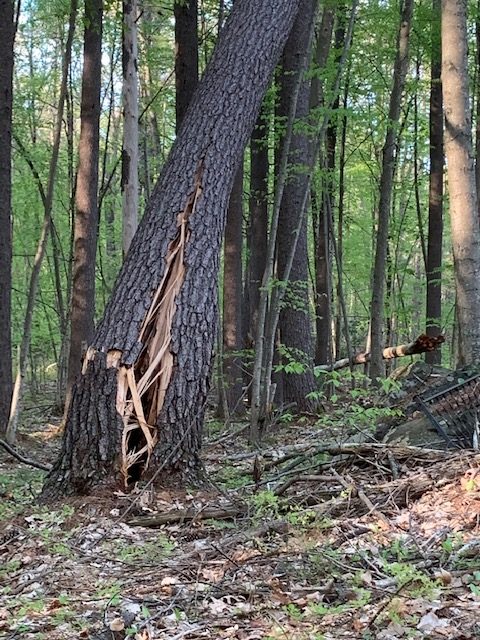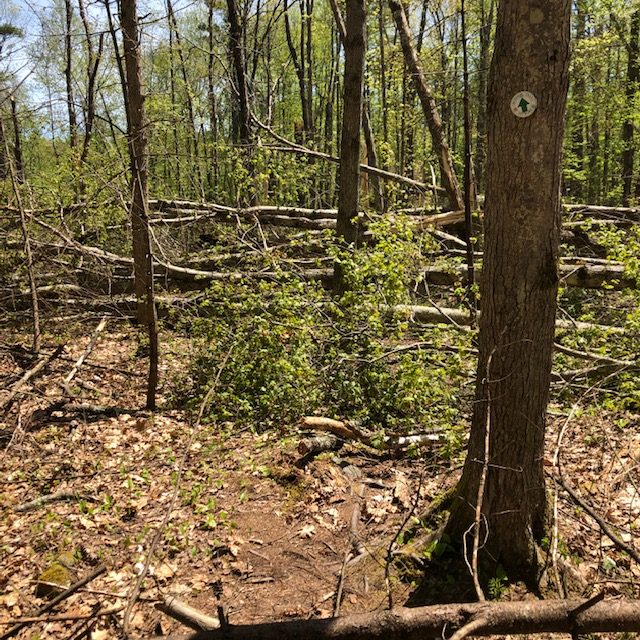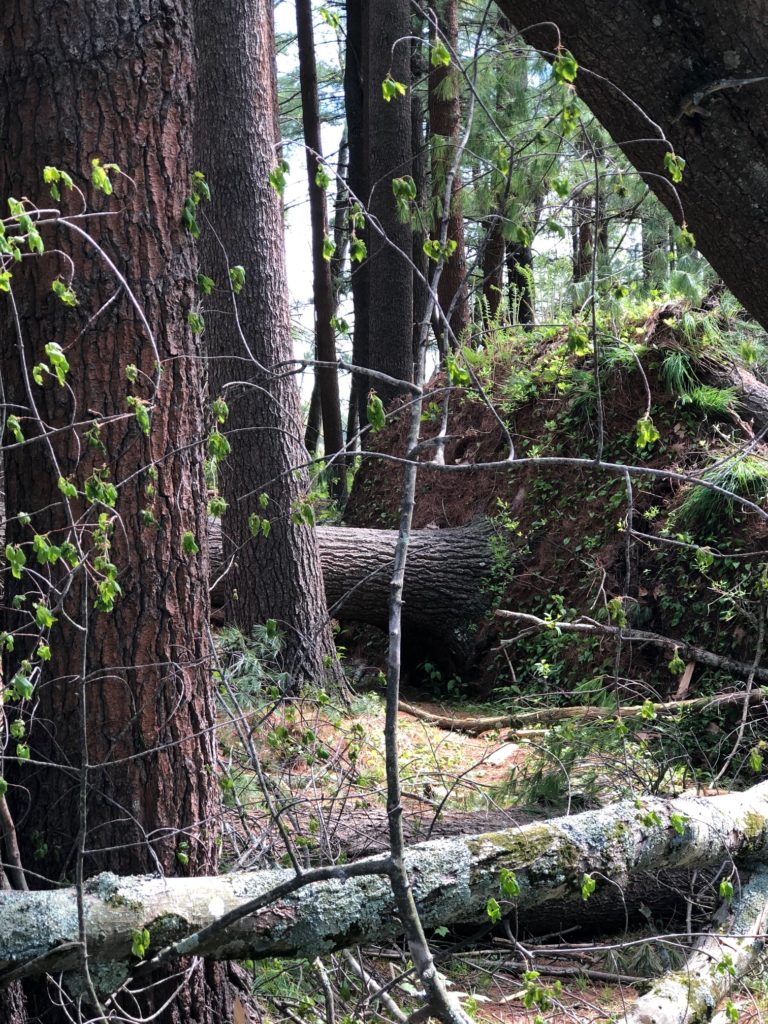By Katy Coburn
On the evening of May 15, a line of intense storms swept across upstate New York and into New England. In an unusual May, during which we experienced snow, hail, and rapidly fluctuating temperatures, the storm elevated to a microburst as it passed across Pepperell, Groton, and Westford with winds reaching 100 mph. Subsequent reports and aerial photos showed the storm traveled in a narrow path over Groton, flattening trees, cutting power lines, and causing substantial property damage.

On the ground, the extent of the damage was jaw-dropping. Volunteers from Groton Conservation Trust visited our Gamlin Crystal Spring and Duck Pond properties the following day to find hundreds of trees and branches leaning precariously and on the ground. Many were covering our trails. Some trails, like the Red Line Path, were impassible and even dangerous, with substantial numbers of snags dangling and ready to fall. Trained volunteers from GCT, the Groton Trails Committee, and the community worked diligently to address the danger, cutting and felling hazardous trees to carefully restore safety to the woods. We reached out to this community and a large number of you responded, volunteering to help begin the long-term process of clearing and open the trails. We thank you for your support and hard work.
But what next? Should we remove the fallen trees and “clean up” the forest? Is there a fire risk? Does the forest need to be restored? Isn’t the timber just going to waste? What about climate change and carbon offsets? Land conservation programs typically consider these questions following any natural or human caused disturbances, and our trustees convened to carefully assess our choices.

Our primary concern is for conservation, though we weigh community concerns seriously when making decisions: what’s feasible, what’s practical, and what best serves the nature of Groton. When in doubt, we revisit our mission: “Groton Conservation Trust enhances the quality of life in our community through environmental conservation, and engages residents in the enjoyment and stewardship of our remarkable natural landscapes.” We always evaluate the impacts of habitat preservation, climate change mitigation, and recreational use in our land protection decisions.
Ecologists have studied forest disturbance events in Cornwall, Connecticut, Yellowstone National Park, and particularly in forests in tropical locations like Puerto Rico, where severe weather events are frequent and widespread. Over many decades of researching shorter and longer term impacts of these events, scientists have found that the environment regenerates on its own. Ecosystems are composed of many elements that work in concert to break down fallen wood and to recycle its nutrients: bacteria, insects, fungi, mycorrhizae, and extensive root systems of growing plants all do their jobs efficiently and continuously.

GCT friend and renowned ecologist Tom Wessels reminded us, when he spoke at our Skitapet property last November, that the best thing people can do to promote the health and vitality of forests is to simply leave them alone. All by themselves, forests (and all ecosystems) will typically regenerate from disturbance events through a process known as succession. We understand, in fact, that ecosystems are dynamic and ever changing, where disturbance is not exceptional nor problematic, and is in fact critical to the functioning of a forest ecosystem. The openings in the forest and the nutrient rich pockets of soil support microhabitats for many of the species that exist in our conservation lands. This mosaic of conditions creates the interplay of resources so important to the preservation of regional biodiversity.
We know fallen trees provide protection from soil erosion and protect other saplings from browsing deer. Wessels also describes, in his book Reading the Forested Landscape, how such trees act as “nurse logs” for new trees (Wessels, 1997). Large trees continue to provide structure and support growth in a forest long after they’ve fallen.

The core of our work is land management, and our overarching goal is to preserve and protect our properties for the benefit of the environment and the community. Groton has a rich and diverse ecology, and we are grateful that we’ve had the opportunity to set aside many kinds of ecosystems. We will closely monitor the properties impacted by the microburst to measure and observe the progress of succession. And we continue to rely on the best practices developed by our scientific and land trust colleagues to make decisions for our land in response to often challenging scenarios.
The work on the Red Line Path is ongoing, and we have a long way to go to establish safe and passable trails. We express sincere gratitude to Paul Funch, the Groton Trails Committee, and many others who continue to work with us on this massive effort. Meanwhile, the work of the forest has already started: a multitude of organisms have begun to decompose the trees, while others adapt to the new influx of light and nutrients. We hope you join us in this fascinating observation of forests in transition.

